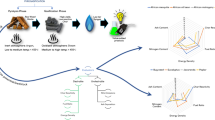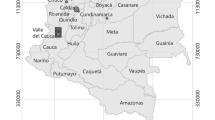Abstract
This report summarizes qualitative information on 5 potential Florida fuelwood species: slash pine, sand pine, melaleuca, eucalypt, and casuarina. The important factors affecting the quality of fuelwood for industrial applications are briefly discussed. Fundamental properties relating to the fuel quality of these 5 potential fuelwoods are synthesized from several published and unpublished reports. Based on the qualitative data shown in this report, it appears that the fuel characteristics of these 5 species are comparable or superior to those of many other woods evaluated in the literature.
Similar content being viewed by others
Literature cited
American Society of Testing and Materials, 1980a. Standard classification of coals by rank. ASTM D 388-77. Philadelphia, PA.
—. 1980b. Standard definitions of terms relating to wood. ASTM D 9-76. Philadelphia, PA.
Brown, H. P., A. J. Panshin, and C. C. Forsaith. 1970. Textbook of Wood Technology. Vol. II. McGraw-Hill, New York.
Conde, L. F., and D. L. Rockwood. 1979. Energy plantation potential in Florida. Proc. Alternative Energy Sources for Florida. Univ. Florida, Gainesville.
Frampton, L. J. 1980. Genetic variation of traits important for energy utilization in sand and slash pines. M.S. Thesis, Univ. Florida, Gainesville.
Harder, M. L., and D. W. Einspahr. 1976. Bark fuel value of important pulpwood species. Tappi 59: 132–133.
Hillis, W. E., and A. G. Brown. 1978. Eucalypts for wood production. Commonwealth Scientific Industrial Research Organization, Australia.
Hough, W. A. 1969. Caloric value of some forest fuels of the Southern United States. USDA Forest Serv. Res. Note SE-120.
Howard, E. T. 1971. Some observations on southern pine needles as related to utilization. Final Rept. FS-SO-3201-1.36 USDA Forest Serv. S. Forest Exp. Sta., Alexandria, LA.
—. 1973. Heat of combustion of various southern pine materials. Wood Sci. 5: 194–197.
Huffman, J. B., and S. Wang. 1980. Heat of combustion of melaleuca biomass. Forest Prod. Res. Soc. Abstr. 34: 24.
Ince, P. J. 1977. Estimating effective heating value of wood or bark fuels at various moisture contents. USDA Forest Serv. Gen. Tech. Rep. FPL 13.
Ince, P. J.. 1979. How to estimate recoverable heat energy in wood or bark fuels. USDA Forest Serv. Gen. Tech. Rep. FPL 29.
Karchesy, J., and P. Koch. 1979. Energy production from hardwoods growing on southern pine sites. USDA Forest Serv. Gen. Tech. Rep. SO-24.
Koch, P. 1972a. Utilization of the southern pine. Vol. I. USDA Forest Serv. Agric. Handbook No. 420.
Koch, P.. 1972b. Utilization of the southern pines. Vol. II. USDA Forest Serv. Agric. Handbook No. 420.
Kossuth, S. V., D. R. Roberts, J. B. Huffman, and S. Wang. 1980. Caloric content of oleoresin soaked pine. Paper presented at 6th N. Amer. Forest Biology Workshop. Aug. 11-13, 1980, in Edmonton, Alberta, Canada.
Martin, R. E. 1963. Thermal and other properties of bark and their relation to fire injury of tree stems. Ph.D. Thesis, Univ. Michigan, Ann Arbor.
— 1969. Characterization of southern pine barks. Forest Prod. J. 19: 23–30.
Murphey, W. K., and B. E. Cutter. 1974. Gross heat of combustion of five hardwood species at differing moisture contents. Forest Prod. J. 24: 44–45.
Neenan, M., and K. Steinbeck. 1979. Caloric values for young sprouts of nine hardwood species. Forest Sci. 25:455–161.
Roberts, D. R. 1973. Inducing lightwood in pine trees by paraquat treatment. USDA Forest Serv. Res. Note SE-191.
Rockwood, D. L., and L. J. Frampton. 1979. Genetic variation in sand pine and slash pine for energy production in silvicultural biomass plantations. Proc. 15th S. Forest Tree Improv. Conf.
Roeder, K. R. 1981. Variation in energy related traits of eucalyptus in south Florida. M.S. Thesis, Univ. Florida, Gainesville.
Saucier, J. R. 1979. Eucalypt and melaleuca—a fuel source for Florida. Paper presented in Forest Prod. Res. Soc. Southeastern Fall Meeting Oct. 10-12, 1979. Panama City Beach, FL.
Smith, M. L., and K. W. Stinson. 1952. Fuels and Combustion. McGraw-Hill, New York.
Smith, W. H., and M. L. Dowd. 1981. Biomass production in Florida. J. Forest. 79: 508–511.
Swain, E. H. F. 1928. The Timbers and Forest Products of Queensland. Queensland Forest Serv., Government Printer, Brisbane, Australia.
Wang, S., and J. B. Huffman. 1982. Effect of extractives on heat content of melaleuca and eucalyptus. Wood Sci. 15: (in press).
—. 1981. Characterization of melaleuca biomass as a fuel for direct combustion. Wood Sci. 13: 216–219.
Author information
Authors and Affiliations
Additional information
Florida Agricultural Experiment Stations Journal Article No. 3313. This paper is based on several technical reports of the research project—Energy and Chemicals from Woody Species in Florida—conducted by the authors.
Rights and permissions
About this article
Cite this article
Wang, Sc., Huffman, J.B. & Rockwood, D.L. Qualitative evaluation of fuelwood in Florida —A summary report. Econ Bot 36, 381–388 (1982). https://doi.org/10.1007/BF02862695
Received:
Accepted:
Issue Date:
DOI: https://doi.org/10.1007/BF02862695




